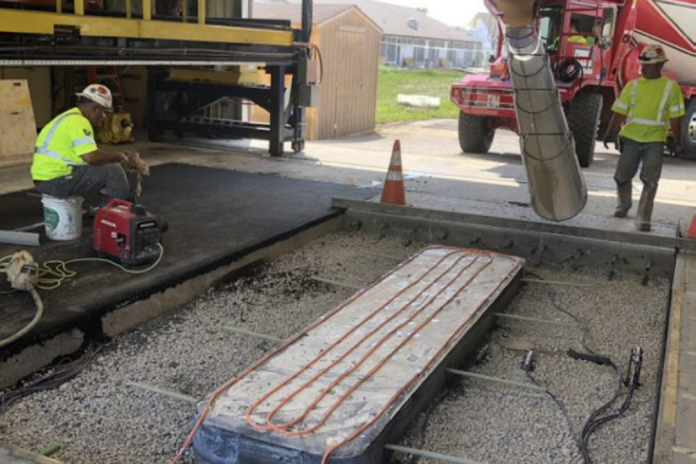A stretch of highway in West Lafayette, Indiana, could soon have the ability to charge electric vehicles (EVs) as they drive over it as part of a project that hopes to expand the new technology across the state’s motorways in the coming years.
In concurrent statements released on Wednesday, the Indiana Department of Transportation and Purdue University announced the “first-of-its-kind” roadway, which is due to be completely by summer 2025 and will see a stretch of the U.S. Highway 231 and U.S. Highway 52 electrified.
The patent-pending technology operates similarly to a wireless phone charger, using magnetic fields to pass electricity between coils—one in the road which transmits and another in the vehicle which receives.
With a rising number of EV drivers on American roads each year, partly incentivized by Biden administration tax credits, EV infrastructure is becoming a key need in the transition to a green economy.
A lack of public charging points and range anxiety—a fear of running out of charge mid-journey—are dominant concerns for prospective EV owners, while some drivers have expressed dismay at the time it takes to charge an EV.
A small-scale test of wireless charging technology is covered with concrete at a wireless charging testing facility in Indiana. Transport officials announced a pilot stretch of highway would be fitted with the technology by next… A small-scale test of wireless charging technology is covered with concrete at a wireless charging testing facility in Indiana. Transport officials announced a pilot stretch of highway would be fitted with the technology by next summer. More Indiana Department of Transportation
Transportation officials in Indiana hope that the dynamic wireless power transfer technology will be able to not only charge standard electric cars but heavy-duty EVs such as tractor trailers as well—which Purdue described as “a unique challenge.”
The university said that wireless charging highways required higher power levels as vehicles move across them faster than city roads, while making them capable of charging larger vehicles would “maximize greenhouse gas reductions” as trucks are one of the biggest sources of emissions in the transportation sector.
“The so-called ‘middle mile’ of the supply chain, which refers to all the travel heavy-duty trucks have to do to carry goods from one major location to another, is the most challenging part of the transportation sector to decarbonize,” Nadia Gkritza, a professor of civil engineering, and agricultural and biological engineering at Purdue, said.
High-powered highways would also augment the economic feasibility of EV infrastructure, the university wrote, as electric trucks could travel further while their battery capacities would not have to be as large.
Construction on the quarter-mile pilot stretch of highway is due to begin on April 1, while Purdue hopes a whole section of the interstate will be electrified in the next four to five years.
Other, similar systems are already being implemented elsewhere in the U.S.: in the Corktown district of Detroit and along a stretch of highway between Seattle and Denver. And some EV manufacturers are beginning to design cars that have the necessary receivers for wireless charging.
From L to R, Purdue University engineers John Haddock, Nadia Gkritza, Dionysios Aliprantis and Steve Pekarek stand in the lab where they are testing their high-power wireless charging technology. They hope it will help cut… From L to R, Purdue University engineers John Haddock, Nadia Gkritza, Dionysios Aliprantis and Steve Pekarek stand in the lab where they are testing their high-power wireless charging technology. They hope it will help cut emissions in the transportation sector and maximize the economic feasibility of EV infrastructure. More Vincent Walter/Purdue University
But Purdue said theirs would be the first electrified highway in the U.S. that provided the power needed for larger vehicles. It has designed systems it hopes will work on both concrete and asphalt roads.
The possibilities may yet be pushed further still. Rather than placing induction coils into the roads, which could prove expensive, engineers at the Massachusetts Institute of Technology (MIT) have developed concrete capable of holding an electric charge.
One researcher who spoke to Newsweek touted the possibility of using the concrete to store energy into the pavement structure itself, allowing EVs to be charged while on the road or in parking spots.



